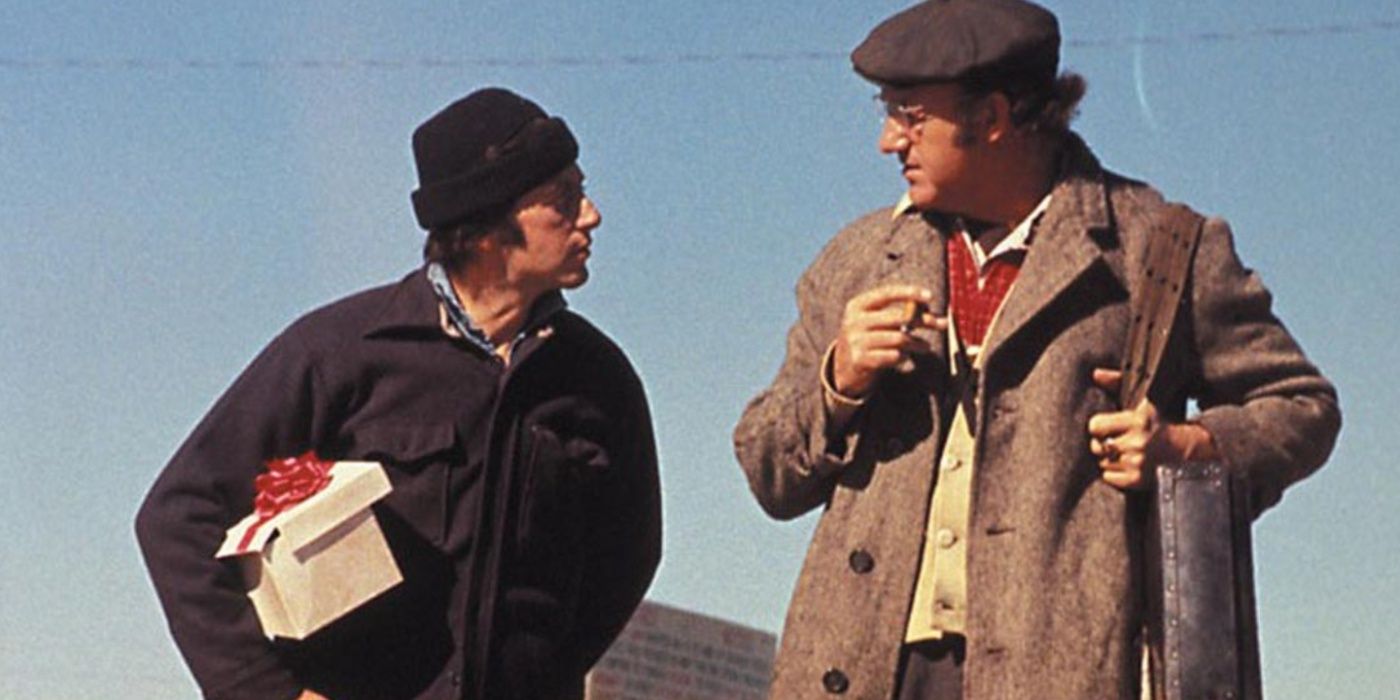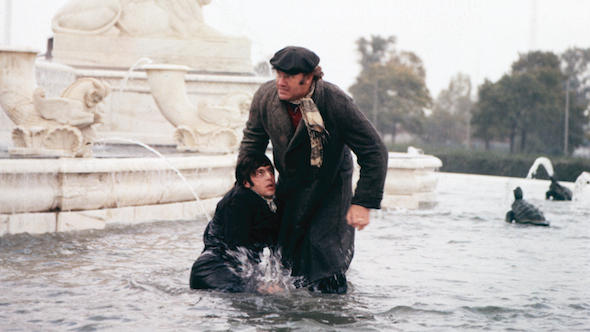my favorite movies of 1973:
(2) Scarecrow
(3) Sleeper
favorite of 1973:
(Richard Dreyfuss, Ron Howard, Cindy Williams, Charles Martin Smith, Candy Clark, Harrison Ford. Directed by George Lucas.)
George Lucas, the director/writer, has said he knew that each plotline in this movie about adolescents in 1962 was a thin “thread,” but they came together to make a “rope.” More memorable than any one of the stories is the bittersweet atmosphere evoked by the ’50s and early ’60s music which suffuses the whole movie.
In this scene, Richard Dreyfuss is riding with his friends when he becomes entranced by a fleeting encounter with a young woman in another car (Suzanne Somers):
Ebert saw the “elusive blonde in the white Thunderbird” as a symbol of “innocence in the process of being lost.” Ebert concluded:
“American Graffiti” is not only a great movie but a brilliant work of historical fiction; no sociological treatise could duplicate the movie’s success in remembering exactly how it was to be alive at that cultural instant.
Stream American Graffiti on Netflix and these sites.
2nd favorite of 1973:
(Gene Hackman, Al Pacino, Eileen Brennan, Dorothy Tristan, Ann Wedgeworth, Richard Lynch, Penelope Allen. Directed by Jerry Schatzberg.)
Scarecrow is the only movie with the late Gene Hackman and Al Pacino together, and their chemistry is something special. Pacino later said he found Hackman difficult to work with. But Hackman, in this David Letterman interview, called it “probably my favorite film to work on.” (See the video below. At the beginning, Lettermen calls Scarecrow “one of my all-time favorite films.”)
Hackman and Pacino play drifters who team up when they meet on a California road. Each man has a goal he wants to achieve with the other’s help … but the goals don’t seem to make sense. Hackman wants them to start a car wash business in Pittsburgh — with virtually no explanation why they should travel across the country to do that, or why Hackman needs Pacino, a simpleton with a childlike sweetness, as his business partner.
Hackman would seem to be the brains of the operation, which is unfortunate since he’s dumb and volatile. He’s fresh out of prison and prone to getting in fights.
Meanwhile, Pacino wants to reconnect with the mother of his 5-year-old and give the kid a gift: a lamp. Why a lamp? Pacino has never met his child and doesn’t even know the kid’s gender, so he picked a gift he could give to either a son or a daughter.
Scarecrow is a rare movie that was shot entirely in order, which likely added to its authentic, rambling quality. People come away from the movie feeling like it doesn’t have much of a plot — yet the two men go through major ups and downs, covering a great distance both physically and emotionally (I won’t spoil how). But the plot feels improvised, as if they came up with each scene on the spot right before filming.
Another reason the movie feels deceptively plotless: the characters’ supposed goals aren’t the real point. They’re an excuse for us to get to know two people who aren’t equipped to deal with the modern world — a world of laws and jobs and relationships they don’t know how to navigate. (Example: Hackman tells Pacino to create a distraction to allow Hackman to shoplift, but Pacino’s attempt at this is so bizarre that it distracts Hackman so much he can’t go through with the shoplifting.) They’re struggling to find some human connection … and realizing that the best they can do might be to make someone laugh.
Stream Scarecrow on these sites.
3rd favorite of 1973:
(Woody Allen, Diane Keaton. Directed by Allen.)
In this sci-fi comedy, Woody Allen continues his absurdist approach to political satire that he started in Bananas (one of my favorite movies of 1971), but now with a more compelling leading woman in Diane Keaton.
Woody Allen plays a health-food store owner in New York City in 1973 who’s frozen after a routine medical procedure goes wrong, until he wakes up 200 years later in a dystopian society where America has turned into a police state, and rebels are trying to use him to infiltrate the government. He tries one weird idea after another to get by in the soullessly automated future, from impersonating an android butler (see the video below), to stealing engineered food that’s bigger than himself, to kidnapping Diane Keaton.
She plays a bad poet with a comfortable lifestyle that’s typical for the year 2173, when people expect to get all their pleasure from technology such as an “orgasmatron,” a machine they step into for instant sex with none of the complications. (When we and Woody Allen first meet Diane Keaton, she’s having some friends over and casually remarks to one of them as they’re leaving: “We should’ve had sex, but there weren’t enough people.”)
Diane Keaton and Woody Allen’s constant squabbling is the heart of Sleeper and points the way to how they’d be paired up again, more seriously and enjoyably, in Annie Hall (my favorite movie of 1977) and Manhattan (my favorite of 1979).
Click here for the full list of my favorite movie(s) of each year from 1920 to 2020.







Comments
Post a Comment
Thanks for submitting a comment on my movie blog! 🎬 Your comment won’t show up here right away. 😐 To make sure your comment gets seen, I recommend sharing this post on social media and saying whatever you feel like! 🤓